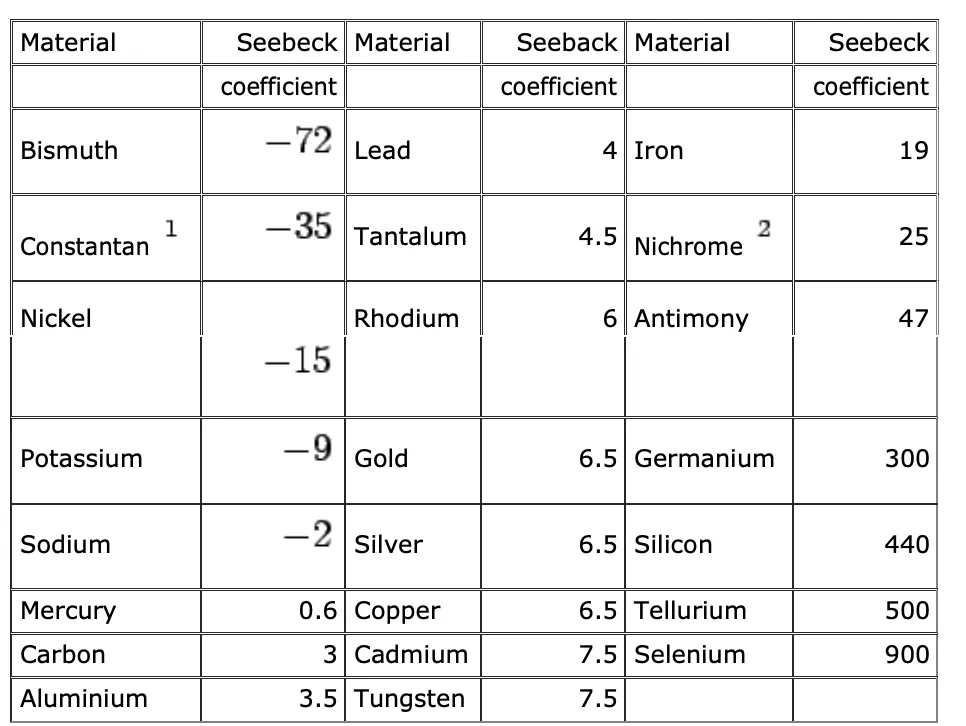What is Seebeck effect?
The Seebeck effect is a phenomenon in which a voltage is generated when two different metals or conductors are joined together at two different temperatures. It is named after the Baltic German physicist Thomas Johann Seebeck, who discovered this effect in 1821.
The Seebeck effect is based on the principle that when there is a temperature gradient across a junction of two dissimilar metals, an electric potential difference, or voltage, is generated. This occurs due to the difference in the behavior of charge carriers (electrons) in the two metals.
Seebeck effect formula
The Seebeck effect is described by the Seebeck coefficient (also known as the thermoelectric coefficient), which relates the voltage generated to the temperature gradient across the junction of two dissimilar materials. The Seebeck coefficient is denoted by the symbol “S” and has units of volts per Kelvin (V/K) or volts per degree Celsius (V/°C).
The formula to calculate the voltage generated by the Seebeck effect is as follows:
- V = S * (T2 – T1)
Where:
- V is the voltage generated across the junction,
- S is the Seebeck coefficient of the thermoelectric materials,
- T2 is the temperature at one junction (hot junction), and
- T1 is the temperature at the other junction (cold junction).
The voltage (V) represents the potential difference between the two junctions and is directly proportional to the temperature difference (T2 – T1) across the junctions.
It’s important to note that the Seebeck coefficient (S) can be positive or negative depending on the combination of materials used and their temperature gradient. A positive Seebeck coefficient indicates that the voltage generated is in the same direction as the temperature gradient, while a negative Seebeck coefficient indicates an opposite direction.
The Seebeck coefficient is typically experimentally determined for specific material combinations and is provided in thermoelectric reference tables or datasheets.
How does the Seebeck effect work?
Here’s a simplified explanation of how the Seebeck effect works:
- When two different metals are joined together to form a circuit, an electrical circuit is created with two junctions: the hot junction and the cold junction.
- If there is a temperature difference between the hot and cold junctions, the charge carriers (electrons) in each metal will have different kinetic energies. The metal with the higher temperature will have more energetic electrons, while the metal with the lower temperature will have less energetic electrons.
- Due to this temperature difference, the more energetic electrons in the hot metal will tend to diffuse to the colder metal, creating a flow of charge carriers.
- As the charge carriers move from the hot junction to the cold junction, an accumulation of charge occurs, resulting in a potential difference, or voltage, across the junctions.
The magnitude of the voltage generated by the Seebeck effect depends on the temperature difference across the junctions and the specific combination of metals used. Different combinations of metals have different Seebeck coefficients, which indicate the voltage produced per unit temperature difference.
The Seebeck effect is the underlying principle behind thermocouples, which are widely used for temperature measurement. In a thermocouple, the voltage generated by the Seebeck effect is measured and correlated to temperature using calibration curves or specialized instruments.
The Seebeck effect has practical applications in various fields, including thermoelectric power generation, temperature sensing, and energy harvesting from waste heat. It forms the basis for the development of thermoelectric materials and devices that can convert heat energy directly into electrical energy.
Seeback Coefficient
The Seebeck coefficient, denoted by the symbol “S,” is a fundamental property of thermoelectric materials that quantifies their ability to generate an electric voltage in response to a temperature gradient. It describes the ratio of the induced voltage to the temperature difference across a material.
Mathematically, the Seebeck coefficient is defined as:
S = -(ΔV / ΔT)
where:
- S is the Seebeck coefficient,
- ΔV is the induced voltage across the material, and
- ΔT is the temperature difference across the material.
The negative sign in the formula indicates that the voltage is generated in a direction opposite to the temperature gradient.
The Seebeck coefficient is typically expressed in units of volts per Kelvin (V/K) or volts per degree Celsius (V/°C).
The Seebeck coefficient is material-dependent and varies with temperature. Different materials can have positive or negative values of the Seebeck coefficient as given in below table. The magnitude and sign of the Seebeck coefficient provide information about the nature and efficiency of the thermoelectric material for converting heat into electrical energy or vice versa.

A large Seebeck coefficient indicates a strong thermoelectric effect, meaning that a higher voltage is generated for a given temperature difference. On the other hand, a small Seebeck coefficient implies a weaker thermoelectric effect.
The Seebeck coefficient is an important parameter in thermoelectric applications, as it is used to evaluate the performance of thermoelectric materials and devices. Materials with a high Seebeck coefficient, combined with good electrical conductivity and low thermal conductivity, are desirable for efficient thermoelectric energy conversion.
